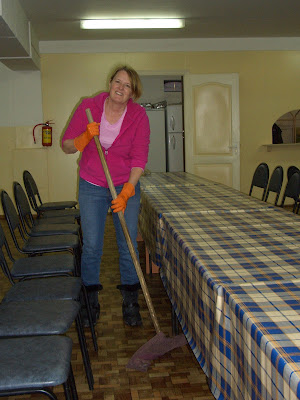Most Monday's I volunteer at a Soup Kitchen at the local Catholic Church. The Soup Kitchen occurs on Monday/Wednesday/Friday and 4 volunteers are needed each day. People from Shell/Schlumberger volunteer on Monday and people from Exxon volunteer on Wednesday. The nuns spend the day before each Soup Kitchen day preparing everything for the soup. They live on the other side of town in a not so nice area. They also spend their days working with children in the neighborhood who are from disadvantaged homes. The sisters usually walk or take a taxi to the church in the summer and take a taxi in the winter.
We arrive at the church around 3:40 and immediately get to work. Before we arrive the sisters have already set each place with a plate of bread and some type of pastry or roll. Depending on the weather and time of year, we have between 70 and 90 people who come to eat. We usually start out preparing for around 75. Here is how the dining room looks when we arrive.
The dishes are stored in this cabinet. The sisters bring the makings of the soup in the square containers you can see to the left of the cabinet. They mix the soup together once thy arrive at the church.
One of us will begin by getting out and counting bowls, and one or two of us will count cups and begin filling them with tea. We then put the cups of tea at each place setting at the table. Below Jenny is getting cups for tea ready.
The room we mainly work in has a stove, refrigerator and counters but no sink. The sink is in another room. Three big pots of soup and a big pot of tea are prepared each day. Here is Jason stirring the soup before we start putting it into bowls. Oh, and there is no hot running water so we have to heat water in the silver and black pot you see in the bottom right of the picture and then carry it into the room for washing dishes.
Here, Linda is putting soup into bowls:
We put the bowls of soup on every available counter and tabletop space:
At about 4:00 the sisters open the side door to the dining room and the people start coming in. They are extremely orderly and usually go to their same spots every time. The sister says a prayer and at that point we serve the soup to the people. Once the soup is served we give everyone a boiled egg. If there is extra, we go back around and give anyone who wants more soup and tea and sometimes bread.
I'm amazed at how orderly and polite the people are, and how quick the whole process is. The sisters, especially sister Margaret (below on the right) is quite stern and keeps everyone in line. She will kick them out if they misbehave or are drunk. I asked very nicely if I could take the photos of the people above and of the sisters. I don't think they usually like it, but I said it was only for my family and friends and so they agreed.
Once everyone finishes eating, they take their dishes to this table below, place trash in the can and leave through the side door you can see on the left in the picture. The sisters will often give out jackets, socks, gloves, and hats that have been donated to the people. Sometimes they even give them medicine and bandage them up.
The sisters are very selfless people. They come from other countries like Poland and Japan and speak English to each other. They are allowed to return to their home country once every 10 years. They write letters home once a month. They don't go to restaurants or have cell phones. They wash their clothes by hand. The Soup Kitchen volunteers take turns taking the dish towels home to wash so that the sisters don't have to wash them by hand.
It's now time to cleanup. One or two of us wash dishes, and one of us brings the dishes to and from the wash room, dries and puts them away. Here is the little room used for washing dishes. When Yuki (shown here below) washes dishes she likes to do it by herself. She is super fast and can finish all the dishes by herself faster than two other people can do together. We all love working when Yuki works.
One of us washes off the tables, the seats and backs of each chair and then mops the floor, usually along with one of the sisters. The last couple of weeks I've been mopping.
The mop that I use is a wooden stick with a towel that is rinsed out and draped over it. It works just fine.
Once all the dishes have been washed, dried and put back in the cabinet and the floors mopped, that's it. We are ready to go. We usually leave anywhere between 5:30 and 6:00.
The next 2 photos are of us leaving the church and the outside of the church.
Here's a photo taken from in front of the church. In the distance is the ski slope that we go to. Since I took this picture, we've gotten more snow.
I enjoy working at the Soup Kitchen and feel like I'm doing just a little bit to help others.
Love to you all!
Karen




























